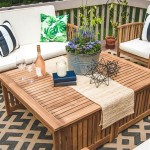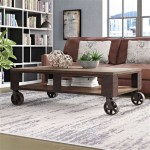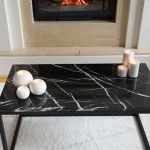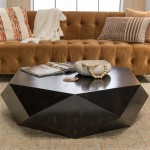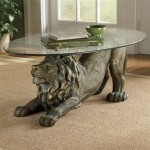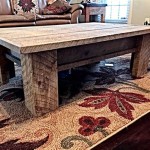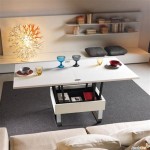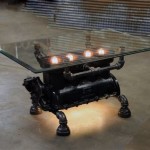How To Choose The Right Ornate Coffee Table Legs Replacement
Replacing ornate coffee table legs can breathe new life into a beloved piece of furniture or provide a unique aesthetic upgrade to a more contemporary table. The selection process requires careful consideration of several factors, including style, size, material, finish, and attachment method, to ensure a seamless and aesthetically pleasing result. This article provides a comprehensive guide to navigate these considerations, empowering readers to make an informed decision when choosing replacement legs for ornate coffee tables.
Assessing the Existing Coffee Table and Desired Aesthetic
Before embarking on the search for replacement legs, a thorough assessment of the existing coffee table is crucial. This involves evaluating the table's overall style, dimensions, and the current condition of the existing legs (if any remain). Understanding the original design intent, or the desired stylistic direction for the upgrade, will help narrow down the options and ensure a cohesive final product.
The table's style can be categorized as traditional, modern, rustic, vintage, or eclectic. Traditional styles often feature elaborate carvings, curved lines, and rich, dark finishes. Modern styles tend to be more minimalist, with clean lines and geometric shapes. Rustic styles emphasize natural materials and a weathered aesthetic. Vintage styles draw inspiration from past eras, such as Art Deco or mid-century modern. Eclectic styles blend elements from different periods and styles, creating a unique and personalized look.
The table's dimensions, including its length, width, and height, are critical for determining the appropriate size and number of replacement legs. The replacement legs should be proportionate to the tabletop to maintain stability and visual balance. A small tabletop might require four slender legs, while a larger tabletop might benefit from thicker, more robust legs or even a central pedestal base. The desired final height of the coffee table should also be taken into account when measuring for replacement legs. Consider how the table will be used and its relationship to surrounding furniture, such as sofas and chairs.
The condition of the existing legs, if present, can provide valuable insights into the table's original construction and attachment method. Inspect the legs for signs of damage, wear, or structural weaknesses. Note the type of material used, the finish applied, and how the legs are attached to the tabletop. This information can help identify suitable replacement options that are compatible with the existing table structure.
Finally, considering the desired aesthetic for the upgraded coffee table is paramount. Replacement legs offer an opportunity to transform the table's overall appearance and complement the surrounding décor. Whether one seeks to restore the table to its original glory or create a completely new look, this vision should guide the leg selection process. Gather inspiration from design magazines, online platforms, and furniture showrooms to identify styles and finishes that resonate with personal preferences.
Selecting the Right Material and Finish
The material and finish of the replacement legs significantly impact the coffee table's durability, aesthetic appeal, and overall value. Common materials include wood, metal, and resin, each offering distinct characteristics and benefits. The finish applied to the legs further enhances their appearance and protects them from wear and tear.
Wood is a classic choice for ornate coffee table legs, offering warmth, versatility, and a timeless appeal. Different types of wood, such as maple, oak, cherry, and walnut, possess varying grain patterns, colors, and hardness levels. Maple is a light-colored hardwood with a fine grain, ideal for painted or stained finishes. Oak is a durable hardwood with a prominent grain, suitable for both traditional and rustic styles. Cherry is a reddish-brown hardwood with a smooth texture, often used for elegant and formal designs. Walnut is a dark-brown hardwood with a rich grain, prized for its luxurious appearance.
Metal legs offer a more contemporary and industrial aesthetic. Common metals used for coffee table legs include steel, iron, and brass. Steel is a strong and versatile metal that can be finished in a variety of colors and textures. Iron is a heavier and more rustic metal, often used for wrought-iron designs. Brass is a warm and elegant metal that adds a touch of luxury to any piece of furniture. Metal legs can be powder-coated, plated, or polished to achieve different looks.
Resin is a synthetic material that can be molded into intricate shapes and finished to resemble wood, metal, or stone. Resin legs are often more affordable than wood or metal legs, and they are resistant to moisture and insects. However, resin legs may not be as durable or aesthetically pleasing as natural materials.
The finish applied to the legs not only enhances their appearance but also protects them from scratches, stains, and moisture damage. Common finishes include paint, stain, varnish, lacquer, and oil. Paint provides a solid color finish and can be easily customized to match any décor. Stain enhances the natural grain of the wood and adds depth and warmth. Varnish and lacquer are clear topcoats that provide a durable and glossy finish. Oil penetrates the wood and provides a natural, matte finish.
When selecting the material and finish for the replacement legs, consider the existing coffee table's material and finish, the desired aesthetic, and the level of durability required. Matching the material and finish to the existing table can create a seamless and harmonious look. Choosing a contrasting material or finish can add visual interest and create a more eclectic style.
Ensuring Proper Attachment and Stability
The method of attaching the replacement legs to the coffee table is crucial for ensuring stability and preventing wobbling or damage. Several attachment methods are available, including screw-in plates, threaded inserts, and mortise-and-tenon joints. The choice of attachment method depends on the table's construction, the type of legs being used, and the desired level of stability.
Screw-in plates are a common and straightforward attachment method. These plates are typically made of metal and feature pre-drilled holes for attaching them to both the leg and the tabletop. The plates are screwed into the leg and then screwed into the underside of the tabletop. This method is suitable for most types of legs and tabletops, and it is relatively easy to install.
Threaded inserts are another popular attachment method. These inserts are metal sleeves with internal threads that are inserted into the tabletop. The legs are then screwed into the threaded inserts, providing a secure and stable connection. Threaded inserts are particularly useful for attaching metal legs to wooden tabletops, as they provide a strong and durable connection that prevents the legs from pulling out.
Mortise-and-tenon joints are a traditional woodworking technique that involves creating a mortise (a hole) in one piece of wood and a tenon (a projection) on another piece of wood. The tenon is inserted into the mortise, creating a strong and interlocking joint. Mortise-and-tenon joints are often used for attaching legs to tables in high-end furniture, as they provide exceptional strength and stability.
Regardless of the attachment method chosen, it is essential to ensure that the legs are properly aligned and securely fastened to the tabletop. Use a level to ensure that the legs are vertical and that the table is level. Tighten all screws or fasteners securely, but avoid over-tightening, which can damage the tabletop or the legs.
For ornate coffee tables, it is often necessary to reinforce the attachment points to provide additional stability. This can be done by adding corner braces or support blocks to the underside of the tabletop. These reinforcements will help distribute the weight of the table and prevent the legs from wobbling or breaking.
Finally, consider the placement of the legs on the tabletop. The legs should be positioned close to the corners of the table to provide maximum stability. If the tabletop is large, it may be necessary to add additional legs in the center of the table to prevent sagging. The number and placement of the legs should be carefully considered to ensure that the table is stable and well-supported.

Diy Farmhouse Coffee Table With Turned Legs Storage Free Plans

Exploring The World Of Table Leg Styles A Beginner S Guide

Metal Coffee Table Legs Flowyline Design

The Easiest Way To Update Furniture Rural Legend

Table Leg Trends For 2024 Design59

Choosing The Best Pedestal Base For A Round Dining Table

4 Pc Traditional Coffee Table Set W Ornate Metal Base Glass Top Deep Merlot

Metal Coffee Table Legs Flowyline Design

418 Curva 28 Inch Dining Table Curved Legs Flowyline Design

Osborne Wood Wooden Coffee Table Legs
Related Posts

